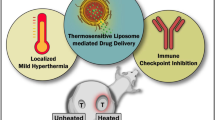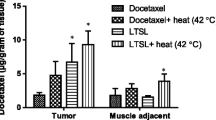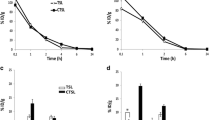Abstract
Liposome formulations of the cancer drug doxorubicin have been developed to address the severe side effects that result from administration of this drug in a conventional formulation. Among them, thermosensitive liposomal doxorubicin presents enhanced tumor targeting and efficient drug release when combined with mild hyperthermia localized to the tumor site. Exploiting the radiosensitizing benefits of localized thermal therapy, the integration of radiation therapy with the thermally activated liposomal system is posited to amplify the anti-tumor efficacy. This study explored a synergistic therapeutic strategy that combines thermosensitive liposomal doxorubicin, mild hyperthermia, and radiotherapy, using an orthotopic murine model of breast cancer. The protocol of sequential multi-modal treatment, incorporating low-dose chemotherapy and radiotherapy, substantially postponed the progression of primary tumor growth in comparison to the application of monotherapy at elevated dosages. Improvements in unheated distant lesions were also observed. Furthermore, the toxicity associated with the combination treatment was comparable to that of either thermosensitive liposome treatment or radiation alone at low doses. These outcomes underscore the potential of multi-modal therapeutic strategies to refine treatment efficacy while concurrently diminishing adverse effects in the management of breast cancer, providing valuable insight for the future refinement of thermosensitive liposomal doxorubicin applications.
Graphical abstract





Similar content being viewed by others
Data availability
The datasets generated during and/or analysed during the current study are available from the corresponding author on reasonable request.
Abbreviations
- DPPC:
-
1,2-dipalmitoyl-sn-glycero-3-phosphocholine
- DPPG2 :
-
1,2-dipalmitoyl-sn-glycero-3-phosphodiglycerol
- DSPE-mPEG2000 :
-
N-(carbonyl-methoxypolyethyleneglycol 2000)-1,2-distearoyl-sn-glycero-3-phosphoethanolamine
- EPR:
-
Enhanced permeability and retention
- HCC:
-
Hepatocellular carcinoma
- HBS:
-
HEPES buffered saline
- HBSS:
-
Hanks’ balanced salt solution
- H&E:
-
Hematoxylin and eosin
- HT:
-
Mild hyperthermia
- MSPC:
-
1-stearoyl-2-lyso-sn-glycero-3-phosphocholine
- RFA:
-
Radiofrequency ablation
- RT:
-
Radiotherapy
- ThermoDXR:
-
Thermosensitive liposomal doxorubicin
- TNBC:
-
Triple negative breast cancer
References
Sung H, Ferlay J, Siegel RL, Laversanne M, Soerjomataram I, Jemal A et al. Global Cancer Statistics 2020: GLOBOCAN estimates of incidence and mortality worldwide for 36 cancers in 185 countries. CA: A Cancer Journal for Clinicians. 2021;71:209–49.
Zagami P, Carey LA. Triple negative breast cancer: pitfalls and progress. NPJ Breast Cancer. 2022;8:1–10.
Soares RF, Garcia AR, Monteiro AR, Macedo F, Pereira TC, Carvalho JC, et al. Prognostic factors for early relapse in non-metastatic triple negative breast cancer — real world data. Rep Pract Oncol Radiother. 2021;26:563–72.
Baranova A, Krasnoselskyi M, Starikov V, Kartashov S, Zhulkevych I, Vlasenko V, et al. Triple-negative breast cancer: current treatment strategies and factors of negative prognosis. J Med Life. 2022;15:153.
Dent R, Trudeau M, Pritchard KI, Hanna WM, Kahn HK, Sawka CA, et al. Triple-negative breast cancer: clinical features and patterns of recurrence. Clin Cancer Res. 2007;13:4429–34.
Bianchini G, De Angelis C, Licata L, Gianni L. Treatment landscape of triple-negative breast cancer — expanded options, evolving needs. Nat Rev Clin Oncol. 2022;19:91–113.
Singal PK, Iliskovic N. Doxorubicin-induced cardiomyopathy. N Engl J Med. 1998;339:900–5.
Northfelt DW, Martin FJ, Working P, Volberding PA, Russell J, Newman M, et al. Doxorubicin encapsulated in liposomes containing surface-bound polyethylene glycol: pharmacokinetics, tumor localization, and safety in patients with AIDS-related Kaposi’s sarcoma. J Clin Pharmacol. 1996;36:55–63.
O’Brien MER, Wigler N, Inbar M, Rosso R, Grischke E, Santoro A, et al. Reduced cardiotoxicity and comparable efficacy in a phase IIItrial of pegylated liposomal doxorubicin HCl(CAELYXTM/Doxil®) versus conventional doxorubicin forfirst-line treatment of metastatic breast cancer. Ann Oncol. 2004;15:440–9.
Barenholz Y, Chezy. Doxil® — the first FDA-approved nano-drug: lessons learned. J Controlled Release. 2012;160:117–34.
Maeda H. Toward a full understanding of the EPR effect in primary and metastatic tumors as well as issues related to its heterogeneity. Adv Drug Deliv Rev. 2015;91:3–6.
Dawidczyk CM, Russell LM, Hultz M, Searson PC. Tumor accumulation of liposomal doxorubicin in three murine models: optimizing delivery efficiency. Nanomedicine. 2017;13:1637–44.
Laginha KM, Verwoert S, Charrois GJR, Allen TM. Determination of doxorubicin levels in whole tumor and tumor nuclei in murine breast cancer tumors. Clin Cancer Res. 2005;11:6944–9.
Mura S, Nicolas J, Couvreur P. Stimuli-responsive nanocarriers for drug delivery. Nat Mater. 2013;12:991–1003.
Needham D, Anyarambhatla G, Kong G, Dewhirst MW. A New temperature-sensitive liposome for use with mild hyperthermia: characterization and testing in a human tumor xenograft Model1. Cancer Res. 2000;60:1197–201.
Dromi S, Frenkel V, Luk A, Traughber B, Angstadt M, Bur M, et al. Pulsed-high intensity focused ultrasound and low temperature–sensitive liposomes for enhanced targeted drug delivery and antitumor effect. Clin Cancer Res. 2007;13:2722–7.
Yarmolenko PS, Zhao Y, Landon C, Spasojevic I, Yuan F, Needham D, et al. Comparative effects of thermosensitive doxorubicin-containing liposomes and hyperthermia in human and murine tumours. Int J Hyperth. 2010;26:485–98.
Palmer GM, Boruta RJ, Viglianti BL, Lan L, Spasojevic I, Dewhirst MW. Non-invasive monitoring of intra-tumor drug concentration and therapeutic response using optical spectroscopy. J Controlled Release. 2010;142:457–64.
Dunne M, Epp-Ducharme B, Sofias AM, Regenold M, Dubins DN, Allen C. Heat-activated drug delivery increases tumor accumulation of synergistic chemotherapies. J Controlled Release. 2019;308:197–208.
Regenold M, Bannigan P, Evans JC, Waspe A, Temple MJ, Allen C. Turning down the heat: The case for mild hyperthermia and thermosensitive liposomes. Nanomed Nanotechnol Biol Med. 2022;40:102484.
Dou Y, Hynynen K, Allen C. To heat or not to heat: challenges with clinical translation of thermosensitive liposomes. J Controlled Release. 2017;249:63–73.
Lepock JR. Cellular effects of hyperthermia: relevance to the minimum dose for thermal damage. Int J Hyperth. 2003;19:252–66.
Dewhirst M, Viglianti BL, Lora-Michiels M, D.v.m PJH, Hanson MA. Thermal dose requirement for tissue effect: experimental and clinical findings. Thermal Treatment of Tissue: Energy Delivery and Assessment II [Internet]. SPIE; 2003 [cited 2024 Feb 4]. pp. 37–57. https://www-spiedigitallibrary-org.myaccess.library.utoronto.ca/conference-proceedings-of-spie/4954/0000/Thermal-dose-requirement-for-tissue-effect--experimental-and-clinical/https://doi.org/10.1117/12.476637.full.
Song CW, Park HJ, Lee CK, Griffin R. Implications of increased tumor blood flow and oxygenation caused by mild temperature hyperthermia in tumor treatment. Int J Hyperth. 2005;21:761–7.
Dunne M, Regenold M, Allen C. Hyperthermia can alter tumor physiology and improve chemo- and radio-therapy efficacy. Adv Drug Deliv Rev. 2020;163–164:98–124.
Skitzki JJ, Repasky EA, Evans SS. Hyperthermia as an immunotherapy strategy for cancer. Curr Opin Investig Drugs. 2009;10:550–8.
IJff M, Crezee J, Oei AL, Stalpers LJA, Westerveld H. The role of hyperthermia in the treatment of locally advanced cervical cancer: a comprehensive review. Int J Gynecol Cancer [Internet]. 2022 [cited 2023 Feb 16];32. https://ijgc.bmj.com/content/32/3/288.
Sherar M, Liu F-F, Pintilie M, Levin W, Hunt J, Hill R, et al. Relationship between thermal dose and outcome in thermoradiotherapy treatments for superficial recurrences of breast cancer: data from a phase III trial. Int J Radiation Oncology*Biology*Physics. 1997;39:371–80.
Peeken JC, Vaupel P, Combs SE. Integrating hyperthermia into modern radiation oncology: what evidence is necessary? Front Oncol. 2017;7:132.
Notter M, Piazena H, Vaupel P. Hypofractionated re-irradiation of large-sized recurrent breast cancer with thermography-controlled, contact-free water-filtered infra-red-A hyperthermia: a retrospective study of 73 patients. Int J Hyperth. 2017;33:227–36.
Wang X, Regenold M, Dunne M, Bannigan P, Allen C. Data demonstrating the in vivo anti-tumor efficacy of thermosensitive liposome formulations of a drug combination in pre-clinical models of breast cancer. Data Brief. 2023;50:109545.
Dou YN, Zheng J, Foltz WD, Weersink R, Chaudary N, Jaffray DA, et al. Heat-activated thermosensitive liposomal cisplatin (HTLC) results in effective growth delay of cervical carcinoma in mice. J Controlled Release. 2014;178:69–78.
Staruch RM, Ganguly M, Tannock IF, Hynynen K, Chopra R. Enhanced drug delivery in rabbit VX2 tumours using thermosensitive liposomes and MRI-controlled focused ultrasound hyperthermia. Int J Hyperth. 2012;28:776–87.
Besse HC, Barten-van Rijbroek AD, van der Wurff-Jacobs KMG, Bos C, Moonen CTW, Deckers R. Tumor Drug Distribution after local drug delivery by hyperthermia, in vivo. Cancers (Basel). 2019;11:1512.
Poon RT, Borys N. Lyso-thermosensitive liposomal doxorubicin: an adjuvant to increase the cure rate of radiofrequency ablation in liver cancer. Future Oncol. 2011;7:937–45.
Lyon PC, Gray MD, Mannaris C, Folkes LK, Stratford M, Campo L, et al. Safety and feasibility of ultrasound-triggered targeted drug delivery of doxorubicin from thermosensitive liposomes in liver tumours (TARDOX): a single-centre, open-label, phase 1 trial. Lancet Oncol. 2018;19:1027–39.
Hsieh Y-C, Wang H-E, Lin W-W, Roffler SR, Cheng T-C, Su Y-C, et al. Pre-existing anti-polyethylene glycol antibody reduces the therapeutic efficacy and pharmacokinetics of PEGylated liposomes. Theranostics. 2018;8:3164–75.
Armstrong JK, Hempel G, Koling S, Chan LS, Fisher T, Meiselman HJ, et al. Antibody against poly(ethylene glycol) adversely affects PEG-asparaginase therapy in acute lymphoblastic leukemia patients. Cancer. 2007;110:103–11.
Ishida T, Maeda R, Ichihara M, Irimura K, Kiwada H. Accelerated clearance of PEGylated liposomes in rats after repeated injections. J Controlled Release. 2003;88:35–42.
Chen JL-Y, Pan C-K, Lin Y-L, Tsai C-Y, Huang Y-S, Yang W-C, et al. Preclinical evaluation of PEGylated liposomal doxorubicin as an effective radiosensitizer in chemoradiotherapy for lung cancer. Strahlenther Onkol. 2021;197:1131–42.
Hagtvet E, Røe K, Olsen DR. Liposomal doxorubicin improves radiotherapy response in hypoxic prostate cancer xenografts. Radiat Oncol. 2011;6:135.
Davies C, de L, Lundstrøm LM, Frengen J, Eikenes L, Bruland ØS, Kaalhus O, et al. Radiation improves the distribution and uptake of liposomal doxorubicin (caelyx) in human osteosarcoma xenografts. Cancer Res. 2004;64:547–53.
Hardenbergh PH, Recht A, Gollamudi S, Come SE, Hayes DF, Shulman LN, et al. Treatment-related toxicity from a randomized trial of the sequencing of doxorubicin and radiation therapy in patients treated for early stage breast cancer. Int J Radiation Oncol Biol Phys. 1999;45:69–72.
Choksey A, Timm KN. Cancer therapy-induced cardiotoxicity—a metabolic perspective on pathogenesis, diagnosis and therapy. Int J Mol Sci. 2021;23:441.
Chung SY, Oh J, Chang JS, Shin J, Kim KH, Chun K-H, et al. Risk of cardiac disease in patients with breast cancer: impact of patient-specific factors and individual heart dose from three-dimensional radiation therapy planning. Int J Radiation Oncol Biol Phys. 2021;110:473–81.
Díaz-Gavela AA, Figueiras-Graillet L, Luis ÁM, Salas Segura J, Ciérvide R, del Cerro Peñalver E, et al. Breast radiotherapy-related cardiotoxicity. When, how, why. risk prevention and control strategies. Cancers (Basel). 2021;13:1712.
Valagussa P, Zambetti M, Biasi S, Moliterni A, Zucali R, Bonadonna G. Cardiac effects following adjuvant chemotherapy and breast irradiation in operable breast cancer. Ann Oncol. 1994;5:209–16.
Willers H, Azzoli CG, Santivasi WL, **a F. Basic mechanisms of therapeutic resistance to radiation and chemotherapy in lung cancer. Cancer J. 2013;19:200–7.
Barker HE, Paget JTE, Khan AA, Harrington KJ. The tumour microenvironment after radiotherapy: mechanisms of resistance and recurrence. Nat Rev Cancer. 2015;15:409–25.
Stutz E, Puric E, Ademaj A, Künzi A, Krcek R, Timm O, et al. Present practice of radiative deep hyperthermia in combination with radiotherapy in Switzerland. Cancers. 2022;14:1175.
Wahl AO, Rademaker A, Kiel KD, Jones EL, Marks LB, Croog V, et al. Multi-institutional review of repeat irradiation of chest wall and breast for recurrent breast cancer. Int J Radiation Oncol Biol Phys. 2008;70:477–84.
Westermann AM, Jones EL, Schem B-C, van der Steen-Banasik EM, Koper P, Mella O, et al. First results of triple-modality treatment combining radiotherapy, chemotherapy, and hyperthermia for the treatment of patients with stage IIB, III, and IVA cervical carcinoma. Cancer. 2005;104:763–70.
Wang Y, Hong W, Che S, Zhang Y, Meng D, Shi F, et al. Outcomes for hyperthermia combined with concurrent radiochemotherapy for patients with cervical cancer. Int J Radiat Oncol Biol Phys. 2020;107:499–511.
Zagar TM, Higgins KA, Miles EF, Vujaskovic Z, Dewhirst MW, Clough RW, et al. Durable palliation of breast cancer chest wall recurrence with radiation therapy, hyperthermia, and chemotherapy. Radiother Oncol. 2010;97:535–40.
Kouloulias VE, Dardoufas CE, Kouvaris JR, Gennatas CS, Polyzos AK, Gogas HJ, et al. Liposomal doxorubicin in conjunction with reirradiation and local hyperthermia treatment in recurrent breast cancer: a phase I/II trial. Clin Cancer Res. 2002;8:374–82.
Besse HC, Bos C, Zandvliet MMJM, van der Wurff-Jacobs K, Moonen CTW, Deckers R. Triggered radiosensitizer delivery using thermosensitive liposomes and hyperthermia improves efficacy of radiotherapy: an in vitro proof of concept study. PLoS ONE. 2018;13:e0204063.
van Leeuwen CM, Oei AL, Chin KWTK, Crezee J, Bel A, Westermann AM, et al. A short time interval between radiotherapy and hyperthermia reduces in-field recurrence and mortality in women with advanced cervical cancer. Radiat Oncol. 2017;12:75.
Overgaard J. The current and potential role of hyperthermia in radiotherapy. Int J Radiation Oncol Biol Phys. 1989;16:535–49.
Mole RH. Whole body irradiation—radiobiology or medicine? BJR. 1953;26:234–41.
Abuodeh Y, Venkat P, Kim S. Systematic review of case reports on the abscopal effect. Curr Probl Cancer. 2016;40:25–37.
Grass GD, Krishna N, Kim S. The immune mechanisms of abscopal effect in radiation therapy. Curr Probl Cancer. 2016;40:10–24.
Reynders K, Illidge T, Siva S, Chang JY, De Ruysscher D. The abscopal effect of local radiotherapy: using immunotherapy to make a rare event clinically relevant. Cancer Treat Rev. 2015;41:503–10.
Galluzzi L, Buqué A, Kepp O, Zitvogel L, Kroemer G. Immunogenic cell death in cancer and infectious disease. Nat Rev Immunol. 2017;17:97–111.
Kroemer G, Galassi C, Zitvogel L, Galluzzi L. Immunogenic cell stress and death. Nat Immunol. 2022;23:487–500.
Zhou J, Wang G, Chen Y, Wang H, Hua Y, Cai Z. Immunogenic cell death in cancer therapy: Present and emerging inducers. J Cell Mol Med. 2019;23:4854–65.
Wang L, Luo R, Onyshchenko K, Rao X, Wang M, Menz B, et al. Adding liposomal doxorubicin enhances the abscopal effect induced by radiation/αPD1 therapy depending on tumor cell mitochondrial DNA and cGAS/STING. J Immunother Cancer. 2023;11:e006235.
Yang X, Gao M, Xu R, Tao Y, Luo W, Wang B, et al. Hyperthermia combined with immune checkpoint inhibitor therapy in the treatment of primary and metastatic tumors. Front Immunol. 2022;13:969447.
Repasky EA, Evans SS, Dewhirst MW. Temperature matters! And why it should matter to tumor immunologists. Cancer Immunol Res. 2013;1:210–6.
Peeters H, van Zwol EM, Brancato L, da Cunha MC, Bogers MG. Systematic review of the registered clinical trials for oncological hyperthermia treatment. Int J Hyperth. 2022;39:806–12.
Huffman OG, Chau DB, Dinicu AI, DeBernardo R, Reizes O. Mechanistic insights on hyperthermic intraperitoneal chemotherapy in ovarian cancer. Cancers (Basel). 2023;15:1402.
Chi M-S, Yang K-L, Chang Y-C, Ko H-L, Lin Y-H, Huang S-C, et al. Comparing the effectiveness of combined external beam radiation and hyperthermia versus external beam radiation alone in treating patients with painful bony metastases: a phase 3 prospective, randomized, controlled trial. Int J Radiat Oncol Biol Phys. 2018;100:78–87.
Oei AL, Korangath P, Mulka K, Helenius M, Coulter JB, Stewart J, et al. Enhancing the abscopal effect of radiation and immune checkpoint inhibitor therapies with magnetic nanoparticle hyperthermia in a model of metastatic breast cancer. Int J Hyperth. 2019;36:47–63.
Regenold M, Wang X, Kaneko K, Bannigan P, Allen C. Harnessing immunotherapy to enhance the systemic anti-tumor effects of thermosensitive liposomes. Drug Deliv Transl Res. 2023;13:1059–73.
Viglianti BL, Dewhirst MW, Boruta RJ, Park J-Y, Landon C, Fontanella AN, et al. Systemic anti-tumour effects of local thermally sensitive liposome therapy. Int J Hyperth. 2014;30:385–92.
Fares J, Fares MY, Khachfe HH, Salhab HA, Fares Y. Molecular principles of metastasis: a hallmark of cancer revisited. Sig Transduct Target Ther. 2020;5:1–17.
Fidler IJ, Kripke ML. Metastasis results from preexisting variant cells within a malignant tumor. Science. 1977;197:893–5.
Acknowledgements
This study was supported by a CIHR project grant to C.A. The authors acknowledge the use of equipment in the Centre for Pharmaceutical Oncology (CPO) at the University of Toronto as well as at the STTARR Innovation Centre (University Health Network). Graphical abstract and Fig. 1 were created using Biorender.
Funding
This work was supported by a CIHR project grant to C.A (Grant Number PJT155905).
Author information
Authors and Affiliations
Contributions
Xuehan Wang: conceptualization, methodology, investigation, analysis, writing-original draft, writing-revision, and visualization. Christine Allen: conceptualization, writing-review and editing, supervision, funding acquisition.
Corresponding author
Ethics declarations
Ethics approval
All animal studies were conducted in accordance with the guidelines of the Animal Care Committee at the University Health Network (UHN, Toronto, ON, Canada).
Conflict of interest
The authors have no relevant interests to disclose.
Additional information
Publisher’s Note
Springer Nature remains neutral with regard to jurisdictional claims in published maps and institutional affiliations.
Electronic supplementary material
Below is the link to the electronic supplementary material.
Rights and permissions
Springer Nature or its licensor (e.g. a society or other partner) holds exclusive rights to this article under a publishing agreement with the author(s) or other rightsholder(s); author self-archiving of the accepted manuscript version of this article is solely governed by the terms of such publishing agreement and applicable law.
About this article
Cite this article
Wang, X., Allen, C. Synergistic effects of thermosensitive liposomal doxorubicin, mild hyperthermia, and radiotherapy in breast cancer management: an orthotopic mouse model study. Drug Deliv. and Transl. Res. (2024). https://doi.org/10.1007/s13346-024-01654-2
Accepted:
Published:
DOI: https://doi.org/10.1007/s13346-024-01654-2




